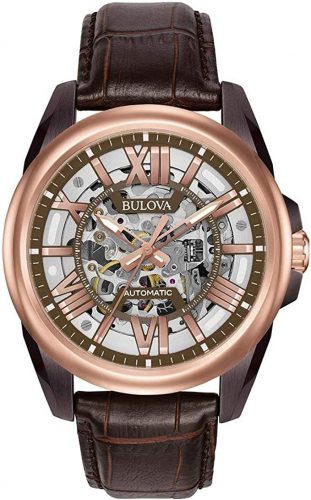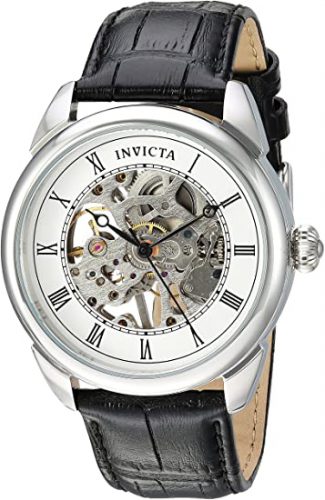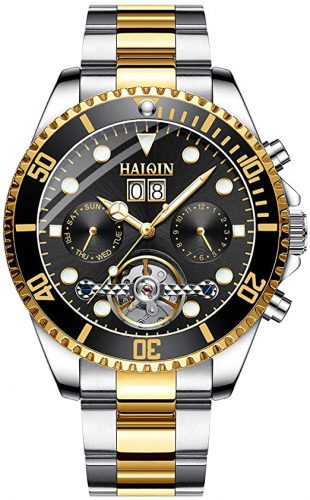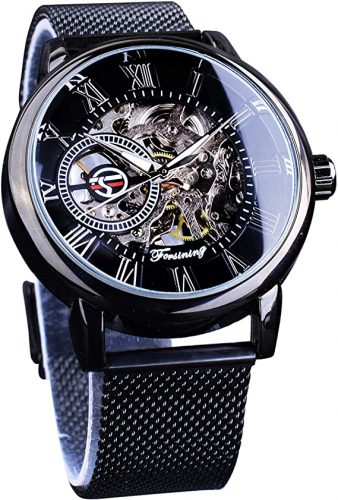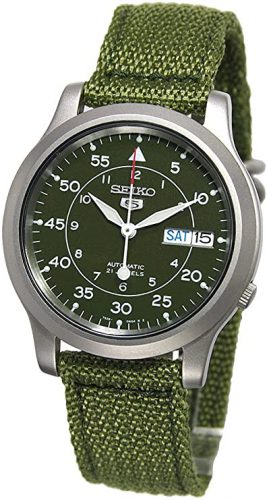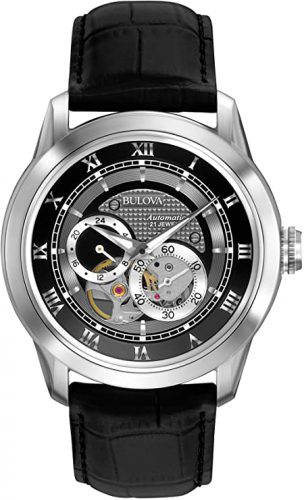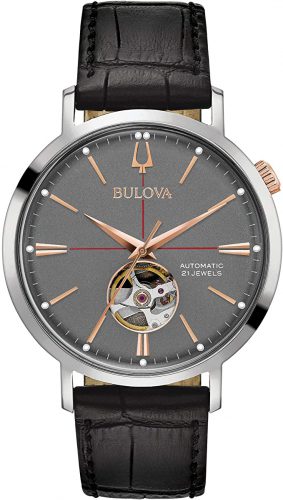Table of Contents:
Watch – practical and fashionable
Have you decided to buy a mechanical watch? Nothing simpler, you can choose either the classic classic mechanical watch from the world, or its more modern version the automatic mechanical watch. Although, they both use mechanical energy, the mechanism of action and the way they procure their energy in order to function make the difference between these two types of watches. The clock is an object that allows us to be aware of the passage of time. The first watch model ever used to work according to the sun. Basically the time was measured according to the movement of the sun. Later, scientists developed a mechanism that turned the clock into a more powerful object, and this invention is still used today. As a result, millions of watch models are available in stores today.
Mechanical watches
The watch, as it was invented, with the simplest type of mechanism. It is the one that must be returned from the crown at regular intervals. The rotation of the crown loads a spring, which then transmits power from wheel to wheel, from the large wheel to the smaller wheel. A component called a “balance” adjusts the accuracy of the watch.Then we can imagine three wheels: a big one, which will rotate the slowest, a medium one and a small one. One of the wheels will count the hour, the other the minutes and the smallest the seconds. They transmit the movement under the dial, where there are other wheels that move those indicators (hourly, minute, secondary). When it comes to mechanical watches, our thoughts fly to the grandfather’s clock that rotates the key every night to keep the clock moving. We already have our quartz watches, which worked with a battery without requiring our intervention, we wonder why my grandfather would get so complicated. But he knew that by his choice he had chosen tradition, prestige and exclusivity, qualities that a simple battery cannot offer. Mechanical watches are among the oldest watches and are made up of gears, springs, screws and other similar elements, all working together in perfect harmony so that the exact time appears on our dial.
Advantages
The very long history of this accessory is what gives the mechanical watch the main advantage: refined elegance over time. Lovers of old (but not only) are fascinated by the way the watch mechanisms look, so much so that many manufacturers leave them in view, through various openings in the front dial or through a transparent dorsal dial. In other words, mechanical watches have a special charm, we could even say a personality. In addition, they are durable, and the mechanisms can work for decades, if properly maintained. The engineering and mechanism that make a mechanical watch work is impressive. Inside the watch case is small wheels and springs that work together to give you time. Sure, no one usually sees the wheels, but that’s part of the charm. A watchmaker has spent hours perfecting a mechanism that is hidden from view. If you appreciate craftsmanship, consider adding a mechanical watch to your collection. Mechanical watches are also more environmentally friendly because they don’t need a battery, so they don’t consume electricity, so they don’t pollute. Because mechanical watches are powered by a spring, which is turned on manually at certain intervals, you will never have to go to the jeweler to change the battery.
Disadvantages
Despite the tradition, the main disadvantage of a mechanical watch is the lack of precision it has, especially compared to a quartz watch. In this respect, the first mechanical pocket watches were ridiculously inaccurate. Although efforts have been made for a long time to remedy this problem, even the most “accurate” watches can have deviations of ± 2-3 seconds per day, while less demanding models have deviations of ± 15-20 seconds a day. If we allow a forced comparison, even the iconic London clock Big Ben – famous for always showing the “exact” time – has a margin of error of two seconds. The perfect watch mechanism has simply not been invented yet. And yet, mechanical watches are much more expensive than quartz watches, because, as we have already mentioned, their realization is laborious and therefore expensive. Although they are resistant to the action of time, they are not as good in terms of shock resistance. The interior mechanisms are quite fragile, which is why they must be inspected and cleaned of dust particles by a professional watchmaker every five years.
Automatic watches
An automatic watch mechanism is based on a part called a rotor. This semicircular piece rotates around an axis that then transfers the generated energy to an arc. Here the energy is released to power the mechanism, but also stored. However, the innovation of this mechanism consists in the way in which the rotor is activated. Therefore, its movement is determined by the movement of the hand of the wearer of the watch. In other words, instead of having to constantly turn the mechanical clock, all you do is move your hand (like, for example, when you walk), and the clock continues to work. For this reason, the automatic clock is also called the perpetual clock. Automatic watches are loved because they are a testament to the skill of watchmakers. It is enough to put an automatic watch on your hand to feel the emotion that hundreds of pieces, springs, sprockets and wheels convey to you, which work synchronously on your wrist. However, the degree of fineness of the mechanism requires that the watch be worn and operated with care, in order to keep it in optimal condition for as long as possible. An automatic watch should continue to work for about two days after you take it off your hand. However, there are situations where you will not want to wear the watch and keep it in the box for several days. In this situation, you can reactivate the automatic clock like any other clock, by simply turning the winder. Rotate the wheel until it begins to resist, then watch if the secondary begins to move. Do not try to force the resistance of the winder, so as not to cause any malfunction of the mechanism and not to shorten the life of the watch. If your automatic watch is not equipped with a winder, you will have to set the rotor in motion by a simple method. Hold the watch in your hand, horizontally, with the dial facing up. Make a few circular motions until you notice that the secondary is moving.
Advantages
More than just a piece of jewelry or a simple accessory, this accessory for men has first of all the great advantage of being simply automatic. Well, yes, simply wearing it on your wrist is more than enough to support it. In this way, its mechanism will not suffer at all. Automatic watches – a lot of advantages not to be neglected. When it comes to the advantages of automatic watches – a lot of things immediately come to mind – it is full of class, less gourmand when it comes to energy, it works with small mechanisms that can be seen most often through the dial. And under those… in other words, it represents a return to the origins or the source. For those who wear their automatic watch daily, the major advantage, which is not negligible, is its maintenance, which is almost nil. It is enough if you return it to its first behavior and if you let it do the rest later. So you will be able to wear it for months without having to return it. The second advantage – its look or appearance. Worn on the wrist, they are the ones that will give you a unique look, a personalized and chic look at the same time. The third advantage – the design of these products. Of course, they have an extremely original design. Most often, their mechanism, also called skeleton, can be seen through the mineral glass that covers the dial. For this reason, manufacturers pay the utmost attention and care to the elements that make them up. Also, the lifespan of an automatic watch is almost infinite. It only needs free mechanical energy to operate. In addition, spare parts are very easy to find and not very expensive.
Disadvantages
Automatic watches are more sensitive to mechanical shocks than usual ones. They also do not withstand extreme temperatures very well. The accuracy of an automatic watch will never be as great as that of a quartz crystal. However, you can opt for a tourbillon model to improve this function, even if opinions about its usefulness are divided. The fact that an automatic watch does not fall into the category of cheap watches is probably the biggest inconvenience. Another disadvantage is the need to take the watch to a specialist for adjustments and cleaning at regular intervals. This means an extra investment and more time dedicated to the care of your automatic watch. This step is rarely performed for models of a few hundred lei, but it is absolutely mandatory if you decide to make a larger investment than that, in which case the maintenance costs are more than justified both financially and in terms of operation.
What is the difference between an automatic and a mechanical watch?
A lot of people don’t know, but automatic watches are actually mechanical watches. The difference between the two is in reinforcement, if the automatic ones load the spring with the simple movement of the hand, the mechanical ones need manual reinforcement in the winder. Classic mechanical watches are fitted with a crown on the outside of the housing, usually on the right side, by means of which a whole system is set in motion which transfers the rotational energy to the main spring. As it tends to relax, it gradually releases energy by moving the entire mechanism. An important role is played here by the rocker or regulator, which ensures a uniform release of energy and therefore more accurate time measurement. On the other hand, automatic watches are equipped with a rotor (an oscillating weight) that moves itself, thus feeding the entire mechanism. This type of watch, if worn by hand, does not require manual adjustment or charging. However, if left at rest, it may stop after a few days.
Precisely (to use a term familiar to watchmaking) you have wondered what is the difference between a mechanical watch and an automatic watch. In fact, automatic watches are also mechanical watches! The difference is in the arming, the automatic ones charging the spring with energy at the simple movement of the hand, no need for manual arming in the winder. The mechanical watch winder is provided, usually on the right side of the outside of the housing, with the so-called “crown”. With its help, by rotating forward, a complicated system of gears and gears is set in motion, which transfers energy to the clock face. When the mechanism is put into operation, the spring relaxes and gradually releases the energy necessary for the operation of the mechanism. There are parts in any mechanical watch whose role is to ensure a uniform release of energy, for a better accuracy of time measurement: rocker arm, rocker arm spiral, anker fork, regulators of various constructions, etc. The arming of a mechanical watch is done manually, once every 1-2 or even more days (mechanical watches with arming have been invented for a long time, even every 8 days). Usually, the power reserve of an ordinary mechanical watch is between 32 and 50 hours. If the clock is not armed within this interval, the mechanism stops. The mechanisms of automatic clocks, however, are provided with a “floor” placed above the mechanical mechanism, a floor that has an oscillating weight (rotor) that moves under the action of its own weight and inertia, thus automatically feeding the mechanism. As long as the watch is worn on the hand, the mechanism loads automatically because the owner makes natural hand movements that make the rotor rotate to one side and the other (in some automatic watches the rotor arms the mechanism in only one direction of rotation, in others it arms in both directions). Caution: if you wear an automatic watch and your work is static (sit with your hand on the desk, or on the steering wheel, etc., in the same position for hours), the rotor does not turn and does not arm the mechanism because your hand does not moves ! One of the advantages of automatic watches is that they are easier to maintain, and one of the disadvantages is that the “floor” of the automatic and the rotor occupies half of the surface of the mechanism, and in the case of glazed back clocks they block most of the mechanical components. Most notice it. Some enthusiasts of watchmaking, or just watches, prefer mechanical watches because by arming them daily, at a certain time, an emotional connection is created.
A lot of people don’t know, but automatic watches are actually mechanical watches. The difference between the two is in reinforcement, if the automatic ones load the spring with the simple movement of the hand, the mechanical ones need manual reinforcement in the winder. Classic mechanical watches are fitted with a crown on the outside of the housing, usually on the right side, by means of which a whole system is set in motion which transfers the rotational energy to the main spring. As it tends to relax, it gradually releases energy by moving the entire mechanism. An important role is played here by the rocker or regulator, which ensures a uniform release of energy and therefore more accurate time measurement.
Mechanical or automatic watch – find out which is best for you
Have you decided to buy a mechanical watch? Nothing simpler, you can choose either the classic classic mechanical watch from the world, or its more modern version the automatic mechanical watch. Although, they both use mechanical energy, the mechanism of action and the way they procure their energy in order to function make the difference between these two types of watches. Remember the grandfather clock you played with when you were a kid? That is an example of a classic mechanical watch made up of many sprockets driven by the energy given by a spring. The spring, in turn, is also supplied with energy by manually turning the key which causes the spring to be tensioned. The disadvantage of this mechanism is that it has to be returned every 24 hours. If you forget to turn it on, the spring inside relaxes, it has no energy, and the clock stops. Unfortunately, only the clock stops, time does not stop. Another problem with these watches is the accuracy with which they indicate the exact time. The accuracy is somewhat relative, ie the deviation that occurs can be +/- 20-30 seconds in 24 hours.
Today, due to advanced parts production technologies and the increasing quality of materials used, expensive mechanical watches have appeared that have a much improved accuracy with a deviation of +/- 2-3 seconds per day. If you take into account the special design they have, you can rightly say that they are real works of art. It’s true that the price is right. It should be remembered that there are both men’s and women’s mechanical watches on the market. The automatic mechanical watch is the undeniable proof of the evolution of the mechanical watch. Many hours of work, sophisticated design calculations, ingenuity and patience are just some of the ingredients used to revolutionize the accuracy, operation and aesthetics of classic mechanical watches. The first step was to change the way they procure their energy. The manual return of the key was abandoned and thus the new automatic men’s watch was launched on the market. It has a perfectly balanced pulley that rotates with the involuntary movement of the hand, providing the energy needed to operate the watch. In short, if you keep your watch on hand all the time, you don’t have to manually turn it off the key, but if you take it off for several hours, you have to give it a little energy by turning the key.
As buyers became interested in the new model, the first problems arose. Due to gravity, in certain positions of the hand, automatic mechanical watches begin to lose their accuracy. Solving this shortcoming came with the invention of the tourbillon. This part reduces the errors due to the movement of the watch with the hand and its continuous improvement have also increased the degree of accuracy of automatic mechanical watches. Just as automotive researchers are working hard to find the solution to an engine with as little fuel consumption as possible, so are watchmakers trying to design automatic clocks that measure the flow of time as accurately as possible.
They are preferable to phones
The effort to check the time on the watch is much lower. Instead, in the case of the phone, it should be taken out of your pocket or searched in your bag full of other things. As a result, the time lost checking the time is lower in the case of the watch at the expense of the phone. In addition, if your phone suffers from an instant problem and crashes or shuts down, you have no chance of finding out the time. In comparison, the battery of a wristwatch lasts for several weeks. And the chances of it shutting down at some point are unlikely. Moreover, there are pairs of pants that lack pockets or the existing ones are too small. This would not allow you to carry your phone other than in your hand, which is undesirable for most people. The wristwatch is worn, and sometimes you may forget to wear it, it’s so easy! Checking the time is done instantly, taking a few seconds.
What to choose between a mechanical or Quartz watch?
In fact, it all depends on what you want, your budget and your expectations. Quartz watch is generally more accurate than mechanical and also much less expensive than mechanical watches. The degree of authenticity will also affect your choice. You are now an expert in wooden watches for men or women, all mechanisms combined!
Benefits
The very long history of this accessory is what gives the mechanical watch the main advantage: the refined elegance over time. Old lovers (but not only) are fascinated by the way the watch’s mechanisms look, so much so that many manufacturers leave them in view, through various openings in the front dial or through a transparent back dial. In other words, mechanical watches have a special charm, we could even say a personality. In addition, they are durable, and the mechanisms can work for decades, if properly maintained.
Disadvantage
Despite the tradition, the main disadvantage of a mechanical watch is the lack of precision it has, especially compared to a quartz watch. In this respect, the first mechanical pocket watches were ridiculously inaccurate, a good watch of those times with a deviation of “only” 15 minutes a day. Although efforts have been made for a long time to remedy this problem, even the most “accurate” watches can have deviations of ± 2-3 seconds per day, while less demanding models have deviations of ± 15-20 seconds per day. If we allow a forced comparison, even the iconic London clock Big Ben – famous for always showing the “exact” time – has a margin of error of two seconds. The perfect clock mechanism has simply not been invented yet. And yet, mechanical watches are much more expensive than quartz watches, because, as we have already mentioned, their production is laborious and therefore expensive. Although they are resistant to the action of time, they are not as good in terms of shock resistance. The interior mechanisms are quite fragile, which is why they need to be inspected and cleaned of dust particles by a professional watchmaker every five years.
